
The Interurban is a type of electric railway, with streetcar-like electric self-propelled rail cars which run within and between cities or towns. They were very prevalent in North America between 1900 and 1925 and were used primarily for passenger travel between cities and their surrounding suburban and rural communities. The concept spread to countries such as Japan, the Netherlands, Switzerland, Belgium and Poland. Interurban as a term encompassed the companies, their infrastructure, their cars that ran on the rails, and their service. In the United States, the early 1900s interurban was a valuable economic institution. Most roads between towns and many town streets were unpaved. Transportation and haulage was by horse-drawn carriages and carts. The interurban provided reliable transportation, particularly in winter weather, between the town and countryside. In 1915, 15,500 miles (24,900 km) of interurban railways were operating in the United States and, for a few years, interurban railways, including the numerous manufacturers of cars and equipment, were the fifth-largest industry in the country. By 1930, most interurbans in North America were gone with a few surviving into the 1950s.

Saint Paul's Union Depot is a historic railroad station and intermodal transit hub in the Lowertown neighborhood of the city of Saint Paul, Minnesota, United States. It serves light rail, intercity rail, intercity bus, and local bus services.
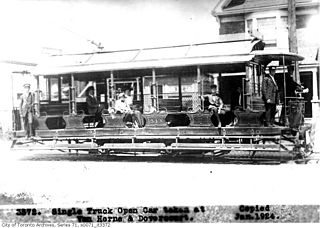
The Toronto Railway Company (TRC) was the operator of the streetcar system in Toronto between 1891 and 1921. It electrified the horsecar system it inherited from the Toronto Street Railway, the previous operator of streetcar service in Toronto. The TRC was also a manufacturer of streetcars and rail work vehicles, a few of which were built for other streetcar and radial operators.

The San Diego Electric Railway (SDERy) was a mass transit system in Southern California, United States, using 600 volt DC streetcars and buses.

The Chicago Aurora and Elgin Railroad (CA&E), known colloquially as the "Roarin' Elgin" or the "Great Third Rail", was an interurban railroad that operated passenger and freight service on its line between Chicago and Aurora, Batavia, Geneva, St. Charles, and Elgin, Illinois. The railroad also operated a small branch to Mt. Carmel Cemetery in Hillside and owned a branch line to Westchester.

The Grand River Railway was an interurban electric railway in what is now the Regional Municipality of Waterloo, in Southwestern Ontario.
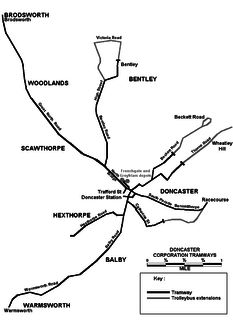
Doncaster Corporation Tramways was an electric tramway network serving the town of Doncaster, England. It was authorised in 1899, and the first route to Bentley opened in 1902. This remained separated from the rest of the system until North Bridge was built to carry traffic over the Great Northern Railway main line to Edinburgh. Soon afterwards, deep mining of coal began in the area, and several extensions to the system were made between 1913 and 1916 to serve new communities which developed around the pit heads. The Racecourse route was unusual, in that it had balloon loops at both ends to enable almost continuous running on race days, a feature that was not common in England, and only found favour in Europe in the 1950s and 1960s.

The Ohio Railway Museum is a railway museum that was founded in 1948. It is located in Worthington, Ohio, near Columbus, Ohio.
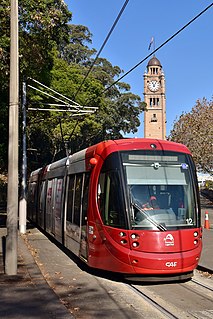
The earliest trams in Australia operated in the latter decades of the 19th century, hauled by horses or "steam tram motors". At the turn of the 20th century, propulsion almost universally turned to electrification, although cable trams lingered in Melbourne. In cities and towns that had trams, they were a major part of public transport assets.
The Aurora, Elgin & Fox River Electric (AE&FRE), was an interurban railroad that operated freight and passenger service on its line paralleling the Fox River. It served the communities of Carpentersville, Dundee, Elgin, South Elgin, St. Charles, Geneva, Batavia, North Aurora, Aurora, Montgomery, and Yorkville in Illinois. It also operated local streetcar lines in both Aurora and Elgin.

The Lehigh Valley Transit Company (LVT) was a regional transport company, headquartered in Allentown, Pennsylvania, that began operations in 1901 as an urban trolley and interurban rail transport company. It operated successfully into the 1930s, struggled financially during the Depression, and was saved from abandonment by a dramatic ridership increase due to the Second World War. In 1951, the LVT, once again financially struggling, ended its 36-mile (58 km) interurban rail service from Allentown to Philadelphia. In 1952, it ended its Allentown area local trolley service. It operated local bus service in the Allentown, Bethlehem, and Easton, Pennsylvania, areas until going out of business in 1972.

The Coopersville Station, built as the Grand Rapids, Grand Haven and Muskegon Railway Depot is a historic railway station once used by the Grand Rapids, Grand Haven and Muskegon Railway in Coopersville, Michigan. The Coopersville Area Historical Society and Museum is now housed in the station.

Dundee Corporation Tramways formerly served the City of Dundee in Scotland. The Corporation had financed the construction of a horse tramway in 1877, but had then leased it to the Dundee and District Tramways Company. They had replaced most of the horse trams with steam tram locomotives pulling trailer cars from 1884, but in 1897 the Corporation decided that it would run the tramway system itself. After some negotiation and the payment of compensation, they took over the system in 1899, with a view to electrifying it. Electric trams started running in 1900, and the changeover was completed in 1902.
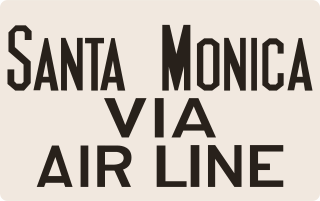
The Santa Monica Air Line was an interurban railroad operated by the Pacific Electric between Santa Monica and downtown Los Angeles. It operated between 1909 and 1953. Most of the route is now used by the Metro E Line.

Streetcars in St. Louis, Missouri operated as part of the transportation network of St. Louis from the middle of the 19th century through the early 1960s. During the first forty years of the streetcar in the city, a variety of private companies operated several dozen lines; from the start of the 20th century, most of these companies consolidated into the St. Louis Public Service Company, which served both the city of St. Louis and neighboring St. Louis County, Missouri. Other private companies, such as those serving the Metro East region or St. Charles, Missouri, continued separate operations. Starting in the 1930s and continuing through the 1960s, St. Louis Public Service ended all streetcar service, while other regional operators also ended their services.
The Nelson Electric Tramway is a heritage railway at Nelson in the West Kootenay region of southeastern British Columbia.
Streetcars in Los Angeles over history have included horse-drawn streetcars and cable cars, and later extensive electric streetcar networks of the Los Angeles Railway and Pacific Electric Railway and their predecessors. Also included are modern light rail lines.
Chartered in 1886, the Canandaigua Street Railroad was a local streetcar line serving the lakeside city of Canandaigua, New York beginning in 1887. The railroad was sold to the Canandaigua Electric Light and Railroad which rebuilt and electrified the line in 1892. The Ontario Light and Traction Company purchased it in 1900, and leased the line to the Rochester and Eastern Rapid Railway in 1903. In 1905, the line came under the control of the Mohawk Valley Company, and in turn, New York State Railways in 1909. Operation was converted to bus operation some time in the 1920s, but this service ended when the Rochester and Eastern Rapid Railway shut down on July 31, 1930. The lease of the former Canandaiua lines was allowed to lapse.
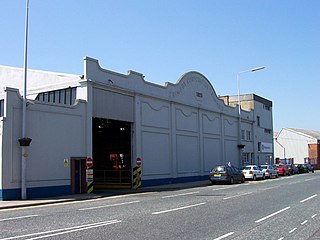
The Great Grimsby Street Tramways Company was a tramway serving Grimsby and Cleethorpes in Lincolnshire, England. It was a subsidiary of The Provincial Tramways Company. They opened a horse tramway in 1881, running from the Wheatsheaf Inn in Bargate to the border with Cleethorpes, with a branch along Freeman Street, and extended the line into Cleethorpes in 1887. It followed the trend of many British systems, and was converted to an electric tramway in December 1901. Small extensions were made to the system at both ends, but the basic plan of the system remained the same throughout its life.

The Lake Erie and Northern Railway was an interurban electric railway which operated in the Grand River Valley in Ontario, Canada. The railway owned and operated a north–south mainline which ran from Galt in the north to Port Dover on the shore of Lake Erie in the south. Along the way, it ran through rural areas of Waterloo County, Brant County, and Norfolk County, as well as the city of Brantford, where it had an interchange with the Brantford and Hamilton Electric Railway. Construction on the mainline began in 1913. The railway began operations in 1916 as a subsidiary of the Canadian Pacific Railway (CPR), which had purchased the line before construction had finished. In 1931, it was consolidated with the Grand River Railway under a single CPR subsidiary, the Canadian Pacific Electric Lines (CPEL), which managed both interurban railways, though they continued to exist as legally separate entities. Passenger service was discontinued in 1955 but electric freight operations continued until 1961, when the LE&N's electric locomotives were replaced by diesel CPR locomotives and the line was de-electrified. In the same year, service on the mainline from Simcoe to Port Dover was discontinued, but the remainder continued to operate as a branchline which as early as 1975 was known as the CP Simcoe Subdivision. The remainder of the line was officially abandoned in the early 1990s, ending almost seventy-five years of operation.















